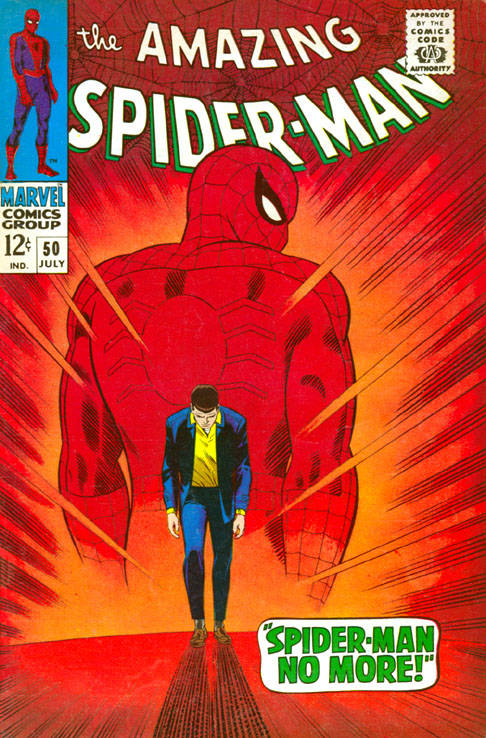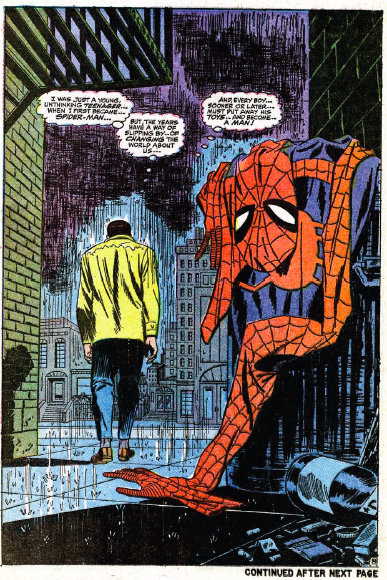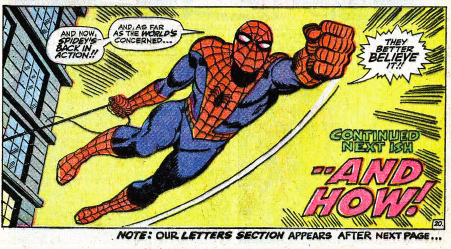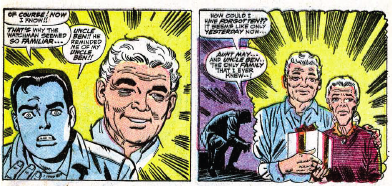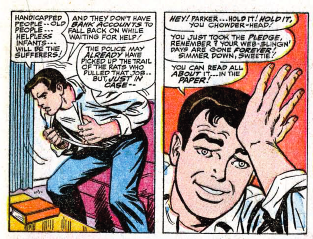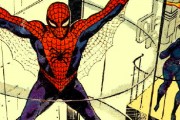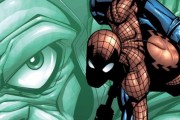2. Amazing Spider-Man #50 (script by Stan Lee, pencils by John Romita Sr., inks by Mike Esposito)
In those moments where I ask myself what made me so motivated to chase after every single issue of Amazing Spider-Man I often come back to ASM #50. It’s among the first super important Silver Age key issues I came to own and in many ways propelled me to the next “level” of hardcore collecting where I was no longer just scouring the internet or comic book shows for $5 or $10 bargains on back issues but rather dedicating my time and resources to finding acceptable copies of some of the most significant comic books in the medium’s history. But even that angle is just half the story. My ownership of ASM #50 is so important to me not only because a bunch of other people have determined the comic’s importance, but because it’s an important comic book that I also happen to love every page of.
I love the story by Stan Lee, as hokey as it might seem for the jaded and cynical. Sure, Stan and Steve Ditko had tackled the idea that Peter Parker was unhappy with the burdens of Spider-Man many times before, but in this iteration of the tale, things felt different. Maybe it was the fact that a layer of gloss and sunshine had been added to Peter ever since Ditko left the title that I could actually accept this hip, cool teenager as someone who would be happier turning in his red and blues and not risking his life every other minute fighting crime as a masked hero. There was now a bigger supporting cast of young people who Peter could interact with in Gwen Stacy, Mary Jane and Harry Osborn (and let’s not forget that Romita’s people looked considerably more contemporary and … er … attractive … than Ditko’s). And just maybe this issue was finally going to be the time that Peter hung up the webs for good.
Of course Peter does come back as Spider-Man at the very end in one of the most triumphant and inspiring panels in the series’ history. “Spidey’s Back in Action” might come across as too monosyllabic for more intellectual readers, but considering the storytelling that brought us to this point, it’s a moment filled with joy and jubilation that still makes me pump my fist in the air every time I read it. There’s a reason that of all the Sam Raimes Spider-Man movies, Spider-Man 2 stands heads and shoulders above the rest, and a big part of it had to do with how Raimes borrowed liberally from the plot of ASM #50.
There’s also a terrific throwback to the origin story, of Peter having to choose between being the protector of the innocent, or ignoring the responsibility that came with his great power. An old defenseless night watchmen, who reminded Peter of his Uncle Ben was in danger. OF COURSE Spider-Man was going to return. Was the premise schmaltzy? Sure, but “It’s a Wonderful Life” is schmaltzy and that doesn’t change the fact that I go out of my way to watch that movie every December and cry like a baby at the end. When a writer is able to tap into our sentimental side so effortlessly, it makes schmaltz completely forgivable.
Beyond that ASM #50 introduces one of the best villains of the Lee/Romita Sr.-era in Kingpin – a character who would go on to be one of Marvel’s most famous antagonists. So not only is the issue great, but it’s historically significant from a “first appearance” standpoint which only adds to its legacy and desirability to collectors.
And then there’s the artwork. Of course the “Spider-Man No More” cover is arguably the greatest Marvel comic book cover in history and it’s certainly my favorite cover in ASM history. But beyond that Romita is on fire throughout this entire issue and demonstrates why his visual interpretation of Spider-Man is certainly the most recognizable and marketable outside of maybe Mark Bagley of the modern-era. If money were no object I would go out of my way to buy as many individual pages of this comic I could find so I could then turn around to frame and hang them like any work of art. It is visually, Spider-Man the way I know and want it.
Of course I can’t talk about this comic book without also mentioning the circumstances surrounding my acquisition. It was a present my wife gave me for our first wedding anniversary. Prior to this she had never given me an old comic book like this before, but with some clever sleuthing, she was able to figure out that this was a comic book that I lusted after not only as a collector, but as a sincere fan of Spider-Man. In the five years that have passed since our first anniversary, I can happily say my wife has given me comic books that are financially worth more than ASM #50, but none that mean as much emotionally to me.
Above everything else, I collect comic books – Amazing Spider-Man comic books – because of the existence of ASM #50. This comic book exists as a portal peering into a generation that came decades before I was born where the comic book medium as a true, worthwhile storytelling device was evolving and changing. While the bulk of the most celebrated comic book storylines and arcs come from the last 30-35 years – Watchmen, Dark Knight Returns, the Dark Phoenix Saga, Days of Future Past, Sandman, etc. – ASM #50 is proof that in the 1960s a comic book was able to deliver a captivating story that in the confines of a single solitary issue was able to set-up a conflict, show that conflict and its potential consequences, and then satisfyingly resolve said conflict in a way that sends everybody home happy. ASM #50 is a big bold classic that gives people like me a reason to rifle through long and short boxes in hopes of making a grand discovery – the chance to come across a comic book that satisfies your every whim as a collector and fan.

